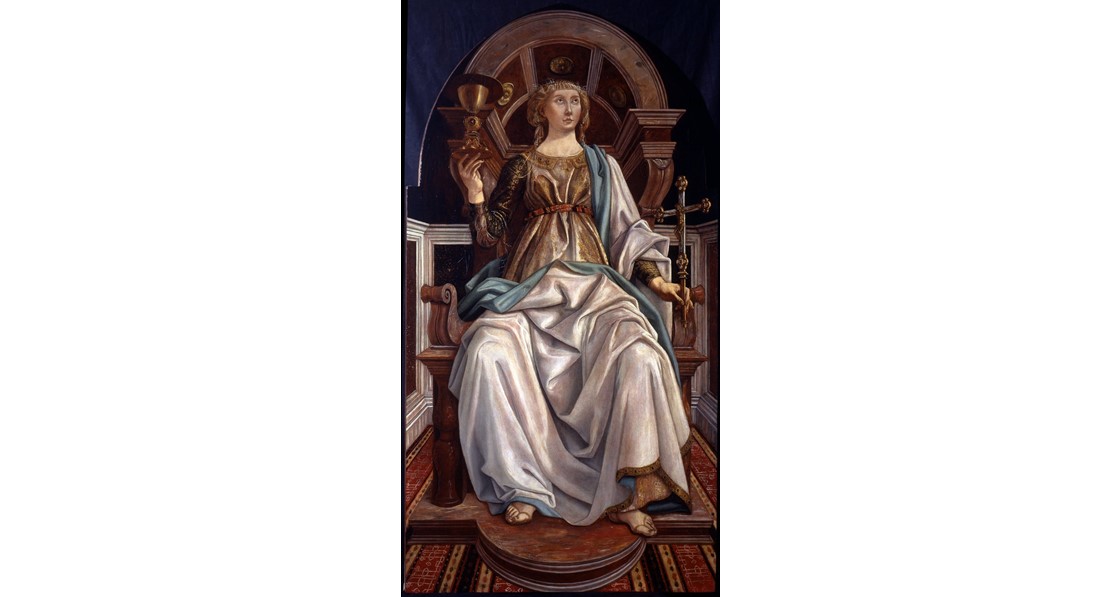+39 0669887260 | info@wucwo.org | Contact us
Art for meditation - January 2024

Piero del Pollaiolo (Florence 1441 - Rome 1496), The Faith, 1470, tempera grassa on panel, 168 x 90.5 cm, Florence, Uffizi Museum
The Virtues: Faith
In this New Year, we would like to offer for reflection and contemplation figures of women that we can certainly define as "special": these are the personifications that artists of the past have made in an attempt to represent the virtues. They are always depicted as women as if to emphasise the indissoluble link between the 'habitual and firm disposition to do the good' (definition of virtue found in the Catechism of the Catholic Church 1803) and the female gender.
This first work, depicting Faith, is part of a cycle of paintings dedicated to the Virtues, commissioned to Piero del Pollaiolo in 1469 and destined for the Sala dell'Udienza of the Tribunale di Mercanzia (the body that heard the commercial disputes of Florentine merchants and administered justice among the members of the arts & crafts) in Piazza della Signoria in Florence.
Faith takes the form of a young woman who occupies almost the entire pictorial space available. With her right hand, she lifts a chalice, covered by the paten, upwards, while in her left hand, she holds a processional cross showing the crucified body of Jesus towards us.
Of course, the objects the woman holds in her hand are not accidental. They are in fact the symbols of the heart of the Christian faith, both of which refer directly to the Lord Jesus: the cross recalls his death and resurrection, while the chalice and paten allude to his real presence in our midst, making direct reference to the sacrament of the Eucharist.
Nor is it accidental that the woman is seated on a throne (this gives her a dignity that in painting is usually reserved exclusively to Mary, among human beings) as well as the fact that her eyes are turned towards heaven: faith indeed urges us to seek "the things above, where Christ is seated at the right hand of God" (cf. Colossians 3:1).
Finally, we are struck both by the precision with which Piero del Pollaiolo reproduces the liturgical ornaments and the elegant composedness of the dress in which the young woman is wrapped. The dominant colour is of course white, because in the Christian tradition it symbolises innocence and purity and, among the so-called 'theological' virtues (faith, hope, charity) it is precisely the colour of faith.
By faith Abraham obeyed when he was called to go out to a place that he was to receive as an inheritance; he went out, not knowing where he was to go. By faith he sojourned in the promised land as in a foreign country, dwelling in tents with Isaac and Jacob, heirs of the same promise; for he was looking forward to the city with foundations, whose architect and maker is God. (Hebrews 11: 8-10)
And the apostles said to the Lord, «Increase our faith» The Lord replied, «If you have faith the size of a mustard seed, you would say to (this) mulberry tree, “Be uprooted and planted in the sea”, and it would obey you». (Luke 17:5-6)
But if Christ is preached as raised from the dead, how can some among you say there is no resurrection of the dead? If there is no resurrection of the dead, then neither has Christ been raised. And if Christ has not been raised, then empty (too) is our preaching; empty, too, your faith. (1 Corinthians 15:12-14)
(Contribution by Vito Pongolini)